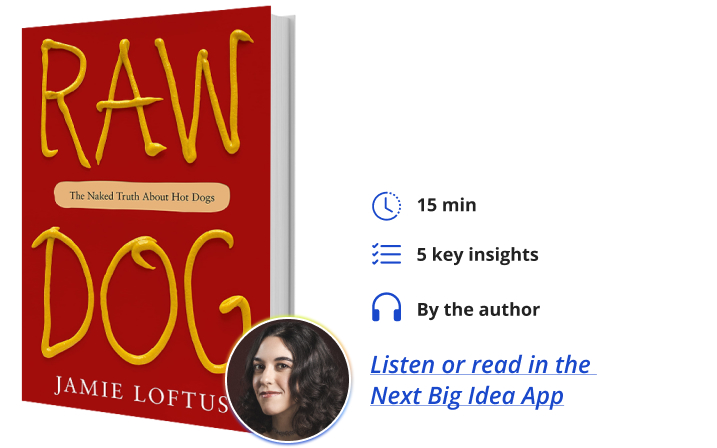Jamie Loftus is an Emmy-nominated comedian and writer. She’s previously worked as a writer for shows like Robot Chicken, Teenage Euthanasia, and Star Trek: Lower Decks. She is also an award-winning host and producer of investigative podcasts like My Year in Mensa, Lolita Podcast, Aack Cast, and Ghost Church.
Below, Jamie shares 5 key insights from her new book, Raw Dog: A Naked History of Hot Dogs. Listen to the audio version—read by Jamie herself—in the Next Big Idea App.

1. Every food story is a labor story.
The food stories we tell each other tend to skew personal or cultural. That’s why every Food Network show you’ve ever watched with a fever opens with the chef telling you that this is a soup their grandma used to make, this is a hoagie their husband loved before he disappeared under mysterious circumstances one morning, this is the dessert that makes them feel closest to their country of origin from a thousand miles away.
What I rarely see discussed is the labor involved in getting us those foods, labor that’s often underpaid and overworked. This was one of the first major aspects of the hot dog that is rarely written about. But it is just as relevant as the fuzzy feeling or bizarro taste of the dish. The hot dog tells a story of class, of CEOs exploiting factory labor, busting unions, and discriminating against a majority poor and immigrant workforce, allegedly so that the product can remain cheap. There have been very few improvements in meatpacking factories since Upton Sinclair’s The Jungle prompted changes in law toward animals and laborers in the early 1900s. Looking at the horrific, completely government and corporation-sanctioned conditions in which meatpacking employees were forced to expose themselves to COVID-19 long before a vaccine was available turned my stomach.
The thing is, working conditions don’t have to be like this for the hot dog to remain affordable. What would be necessary is for CEOs to be less predatory and greedy about their personal profits, and allow the once-strong unions in the meatpacking sector to rebuild. There is an ethical and affordable way to consume a hot dog, but you’d never know it from the shamelessness with which most American companies treat their employees.
2. Every hot dog origin story you’ve heard is made up.
There are a slew of hot dog origin stories. There’s the one at the baseball game where the vendor gave out little white gloves to hold a hot sausage before realizing perhaps a bun would work better. There’s the one where the hot dog and the hot dog cart were invented on the same day. There’s also the one where it was too rainy for ice cream and peanuts and a concession stand owner improvised. All lies, but they sound pretty good, right?
“The reality is far more collective.”
All these business myths have two things in common: they take place in the early 1900s, and they rely on one guy pulling himself up by his bootstraps and prompting a hot dog empire. It’s a myth we see a lot today, whether it’s Bill Gates starting Microsoft out of a garage or Elon Musk doing whatever weird lie he’s telling right now. The reality is far more collective, with hot dogs developing out of the sausage traditions of German, Polish, Austrian, and Greek food traditions, becoming popular during the Great Depression for its affordability and being further refined by Industrial Revolution machinery. It’s not sexy, but it’s true.
3. Justice for women hot dog eaters!
No area of the hot dog universe is impervious to systemic injustice, including the Nathan’s Hot Dog Eating contest on Coney Island.
Legendary Japanese competitive eater Takeru Kobayashi initially came to New York to compete in the early 2000s and his signature technique, showmanship, and athletic build instantly exploded the popularity of the contest. For a while, Kobayashi was the Nathan’s Hot Dog Contest. He appeared on TV, garnered sponsorships, and was Major League Eating’s primary champion, before a white male competitor presented a challenge in the form of current champion Joey Chestnut. The owners of Major League Eating saw an opportunity to edge Kobayashi out of the sport for a champion they felt was a “real American,” giving Kobayashi bad deals and poor treatment until he left the sport altogether.
“This meant all the expected injustices.”
That’s nothing to say of how poorly women hot dog eating champions have been treated historically! My favorite person in the Hot Dog Expanded Universe is Sonya “The Black Widow” Thomas, a woman who immigrated from South Korea to the U.S. and was managing a Burger King on a naval base when she discovered her talent at competitive eating. The rest is history: she launched to the top of the field and became a popular figure, before Major League Eating split the contest into men’s and women’s contests in 2011. This meant all the expected injustices—low money from prizes, a bright-pink competitor’s belt, and being relegated to broadcast on ESPN-3 instead of the main-channel event of the men’s contest.
If the only thing this book can do is get the women’s contest back on ESPN, it will all be worth it. Justice for women hot dog eaters!
4. The people who drive the Wienermobile are probably having sex with each other.
Maybe you could have guessed this one, but I’m here to confirm. After trailing a pair of Wienermobile drivers for a few weeks, I was able to access the sexy hot dog gossip no one knew they wanted—yes, the pairs of people driving the Wienermobiles across the country to promote Oscar Meyer products are very likely hooking up with each other.
Here’s how it works: after a rigorous national search, twelve recent college grads are selected to be drivers of the granddaddy of promotional vehicles, the red-and-yellow Wienermobile, for a full year. Pairs are sorted into the six vehicles at random, and drivers get to know each other and…. they’re in their early twenties. There are a number of Wienermobile pairings that have led to marriage over the years and can attest that steamy summer driving across the country is extremely common. When you’re spending six months living in a hot dog and a hotel, what else are you going to do? Whoever gets to tour a Wienermobile in their area, please take a black light to it for me, I want to see about something.
“There are a number of Wienermobile pairings that have led to marriage.”
(Ironically, I learned this from the only pair of drivers who didn’t seem to be in love with each other. They instead described it as an “arranged marriage.”)
5. You need to toast the bun.
This is a polarizing take and maybe will cause you to lose any respect and trust we’ve built over the course of this segment. But my God, you’ve got toast that bun.
In my 200+ hot dog journey, I cannot overstate how many quality dogs were ruined by poor bun infrastructure. Especially if you’re enjoying a regional make with a lot of toppings—think the Chicago dog with the full salad on top, or a good chili dog with a hefty serving. The very worst thing that can happen is for a soft, underprepared bun to turn to liquid gluten in your hands beneath a quality hot dog. Every vendor can give themselves the gift of a superior hot dog and a happy customer with a light toast. I will and have gone to the mat on this issue, and you all need to face the fact that I’m correct.
To listen to the audio version read by author Jamie Loftus, download the Next Big Idea App today:































